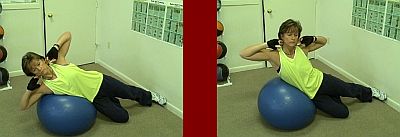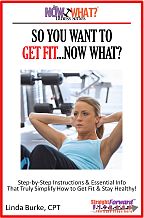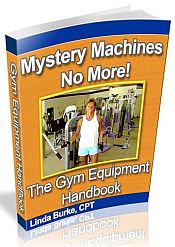

ARE YOU REACHING YOUR BEST THR ZONEWhat's all this fuss about target heart rate, you ask? Well, we know to improve our cardiovascular endurance we must perform cardio/aerobic exercise, right? But there is a little more to it than that.GET THIS: We need to get our heart rate up into the desired target heart rate zone for a sustained period of time in order to utilize the overload principle and to lead to substantial fitness improvements over time. Therefore, it's very important to measure the intensity of your cardio workout. According to guidelines your intensity level should be "moderate" or "challenging." If you're not working hard enough you may end up frustrated due to lack of results and if you work too hard you risk injury or burnout. When following a cardio program, there are three main ways to measure your exercise intensity: Target Heart Rate (THR), Rate of Perceived Exertion (RPE) and The Talk Test. Let's take a closer look at all three, shall we? Wikipedia says: The Target Heart Rate or Training Heart Rate (THR) is a desired range (60%–85% of maximum heart rate) reached during aerobic exercise which enables one's heart and lungs to receive the most benefit from a workout. This theoretical range varies based on a person's physical condition and/or fitness level, gender, etc. Training below your target zone may not be intense enough to burn sufficient calories or improve your cardiovascular fitness; while training above your zone means you’re working anaerobically (without oxygen) and inefficiently, which is also too intense for many people, especially beginners. You may use the following as a guide for determining your intensity level:
HOW TO FIGURE YOUR HEART RATE MAX AND TARGET HEART RATE The maximum heart rate (HRmax) is the highest heart rate an individual can safely achieve through exercise stress, and depends on age. The most accurate way of measuring HRmax is via a cardiac stress test. In such a test, the subject exercises while being monitored by an EKG. During the test, the intensity of exercise is periodically increased (if a treadmill is being used, through increase in speed or slope of the treadmill), continuing until certain changes in heart function are detected in the EKG, at which point the subject is directed to stop. Typical durations of such a test range from ten to twenty minutes. Conducting a maximal exercise test can require expensive equipment. People just beginning an exercise regimen are normally advised to perform this test only in the presence of medical staff due to risks associated with high heart rates. For general purposes, people instead typically use a formula to estimate their individual maximum heart rate. Various formulas are used to estimate individual maximum heart rates, based on age, but maximum heart rates vary significantly between individuals. Even within a single elite sports team, such as Olympic rowers in their 20's, maximum heart rates can vary from 160 to 220. The most common formula encountered is HRmax = 220 – age. This formula has been attributed to various sources, but is widely thought to have been devised in 1970 by Dr. William Haskell and Dr. Samuel Fox. Inquiry into the history of this formula reveals that it was not developed from original research, but resulted from observation based on data from approximately 11 references consisting of published research or unpublished scientific compilations. It gained widespread use through being used by Polar Electro in its heart rate monitors, which Dr. Haskell has "laughed about", as it "was never supposed to be an absolute guide to rule people's training." The actual equation for target heart rate is 220 - age x target heart rate percentage. For example: A 28-year-old wanting to do 85% intensity would go for a target heart rate of about 163 BPM (beats per minute) and about 27 BPM for a 10-second count. 220 – 28 = 192 192 x 85% = 163 beats per minute. Divide that by 6 for a 10-second count of 27. However, there is a great deal of controversy over the 220-minus-age theory. Here it is in a nutshell: It overestimates the maximum rate in young adults, does a pretty good job for people who are around 40 years old, and then increasingly underestimates the maximum rate as people get older. Apparently, it can be off by as much as 30 beats or so. And as I mentioned earlier, the guy who started it didn't EVEN mean for it to become the “law” of max heart rates. However, you see the charts in gyms everywhere and people treat it like the gospel of target heart rates. Another concern is the fact that some high blood pressure medications lower the maximum heart rate and thus the target zone rate. You can see where this can get very tricky. BOTTOM LINE: Use caution when using age group average maximal heart-rate tables and the 220-minus-age formula for the aforementioned reasons. For the general population whose goals are usually general fitness improvements or weight loss, the methods of RPE and the Talk Test are quite sufficient. Therefore, I suggest you use a combination of THR (target heart rate) if you desire, the RPE (ratings of perceived exertion), and the talk test (explained below) when exercising and you should be able to find your best training zone. NOTE: If you are in the habit of trusting the built-in heart rate monitor on your favorite piece of cardio equipment, you may want to give it an accuracy test by checking your heart rate manually and comparing the numbers. Many times these are inaccurate and should not be solely relied upon for monitoring your intensity. Say! Did you know that you can follow me on Facebook? Well, you can! Jump on over to Facebook.com/StraightforwardFitness and "like" my page, please. I post a fitness tip daily. Feel free to leave comments and check in often. Thanks ever so much! EXCITING ANNOUNCEMENT!!! In the next few weeks I will be launching my latest project. It is a series of Kindle fitness books that will be for sale at Amazon.com. The Now What? Fitness Series is a series of six books that will help anyone who wants to begin a health and fitness program know exactly what they need to do and exactly how to do it. In fact, I pulled the THR article featured in today's newsletter straight from one of the books, "So You Want to Do Cardio...Now What?" These books are succinct and easy to read yet jam-packed with need-to-know info without all the hype, fluff, and filler you'll find in other fitness books. I will send out an announcement before the actual release so you can be the first to take advantage of these great little time-saving, life-changing books! EXERCISE OF THE MONTH This is the part of the newsletter where I picture an exercise and give explicit instructions on its proper execution. This exercise really hits the waistline like no other. It is a bit tricky, but once you get it right you'll love the way it feels like it's truly targeting your waist! Swiss Ball Side Raises Primary Muscle Group Worked: Oblique muscles. (Side abs). Secondary Muscle Groups Worked in this Exercise: Abdomen and oblique muscles. 
To see a video of this exercise go to: Side ball raise vid. Preparation: Kneel sideways to the wall about a foot away from the wall with an exercise ball at your side as shown. Bend leg closest to the ball at a 90 degree angle and position your body sideways across the ball with hands just below ears. Nearly straighten the other leg and lodge it against the wall for balance. Execution: Exhale as you bend at the torso up towards the wall as far as you can and pause and return to the straight torso position. Repeat for the desired amount of reps. Wait about 30 seconds and do your next set. When you are finished with that side don't forget to turn and do the other side. HEREIN LIES THE CHALLENGE: The hard part about this is finding the right position. It's easy to get the ball too far under the armpit or too far under the hip. Either of those makes doing the exercise feel awkward and difficult. However, find the right spot and you just know it! It really hits the waistline like no other! This is tricky, so focus and remember practice makes perfect. TIP: Once you find the sweet spot, stay on that side until you've done all your sets before switching positions for the other side. THE PONDER POND Okay, peeps! This is the inspirational part of the newsletter known as the "Ponder Pond" where you're welcome to take a swim in the sweet waters of inspiration. In 1997, Julia Butterfly Hill sent an international message through her silent protest, living 738 days in the branches of “Luna”, a 1,000 year old Redwood Tree. From 20 stories high, she witnessed first hand the devastation of “clear cutting”, a method of cutting down these ancient trees. In this video, Julia offers a profound message about viewing the world as a whole, overcoming separation and expanding our consciousness. She is a true visionary I think we all could benefit from taking the time to listen to her story. Well, that's about it for this time! I hope you enjoyed this month's newsletter and until the next issue, may the wind be at your back and improved health and vitality your new reality! If you enjoyed this newsletter, please feel free to pay it forward to anyone you think would like it too. That is the best compliment you could ever pay me, and I appreciate it very, very much. And don't forget to tell everybody about Straightforwardfitness.com where they can get all the free fitness info their heart desires and sign up for this newsletter while they are there. From my heart to your health, Linda Burke, CPT |
Buy The Now What? Fitness Series Books Here!

To Get a Free Copy of The Gym Equipment Handbook
and Much, Much More...Simply Click on the "Click Here" Button Above or Click on My Book Below and Enjoy All the Free Gifts on That Page That You Want!


